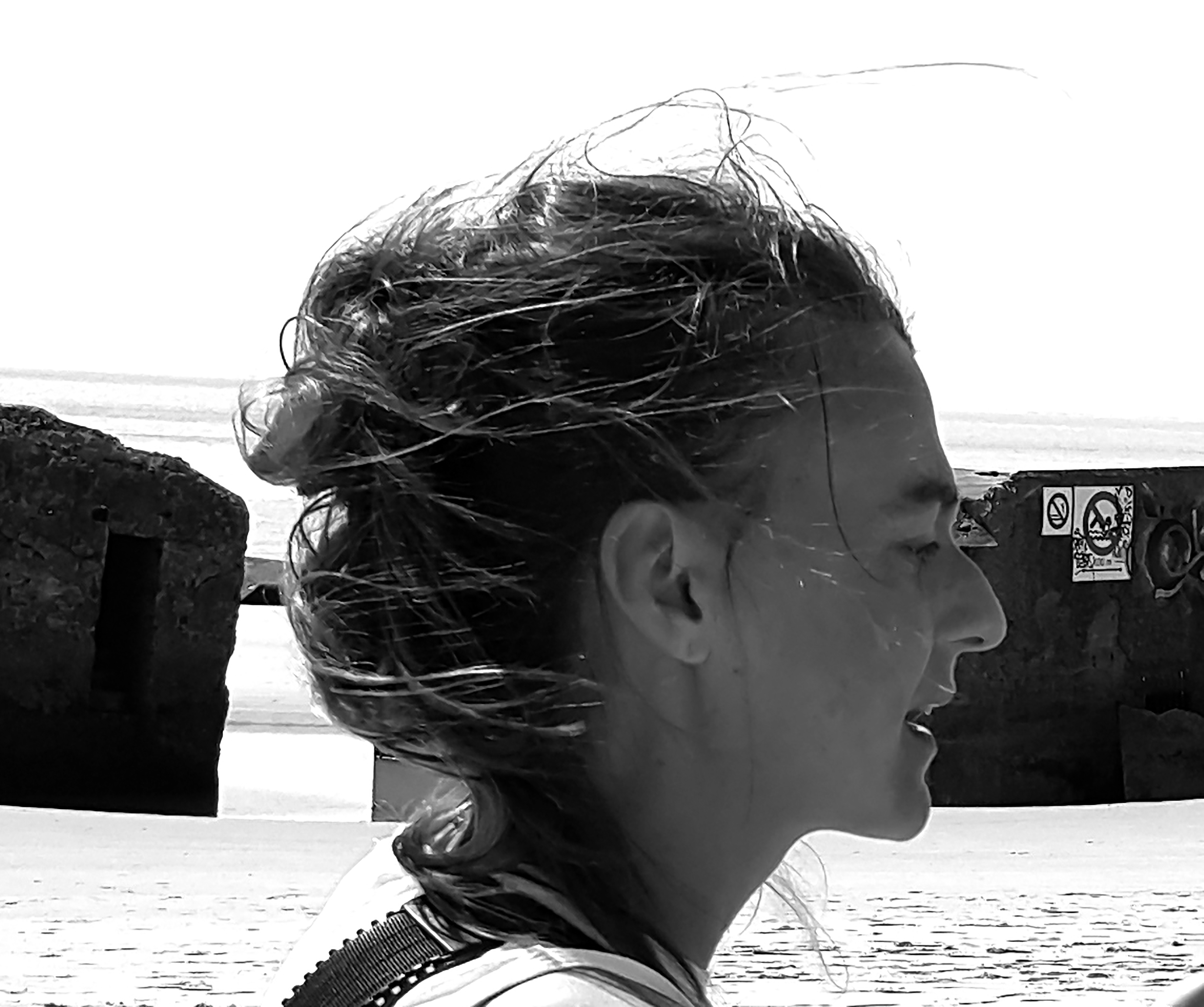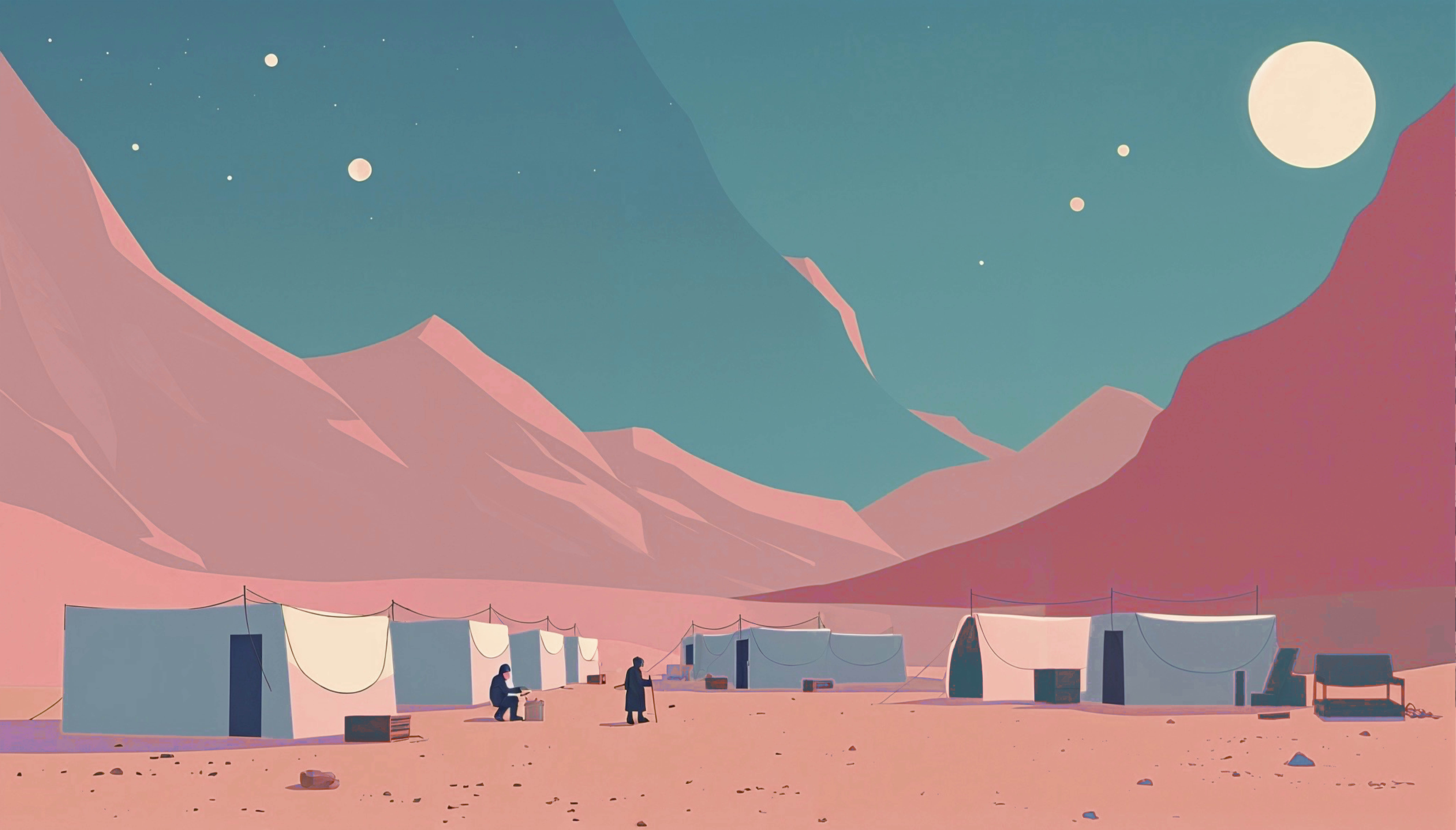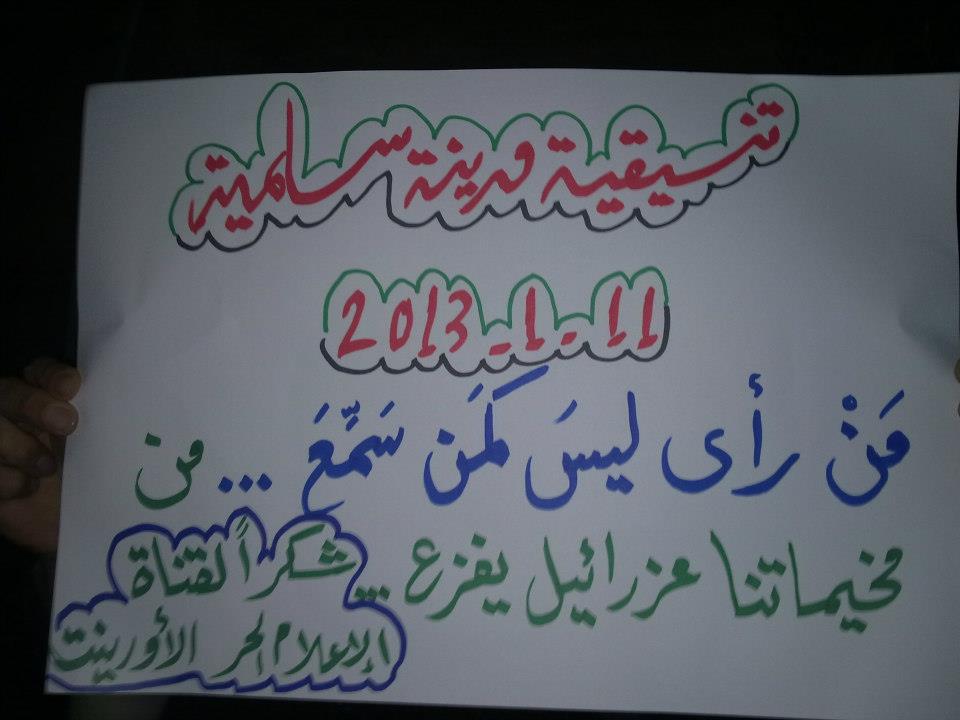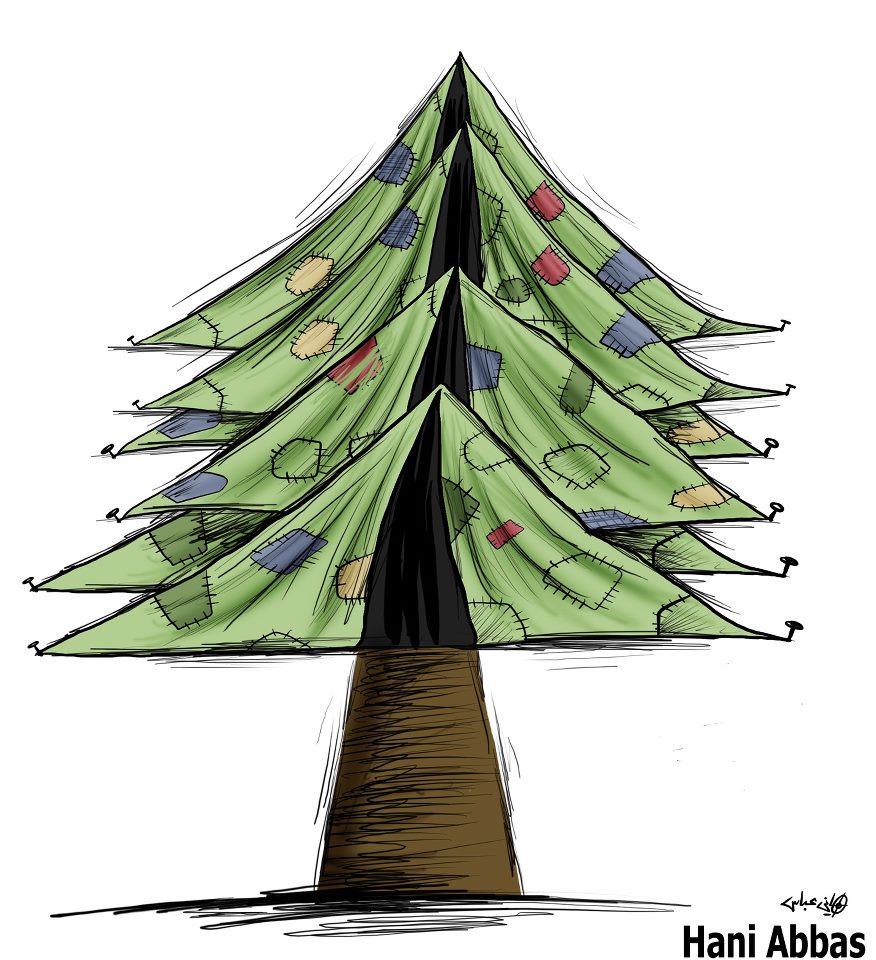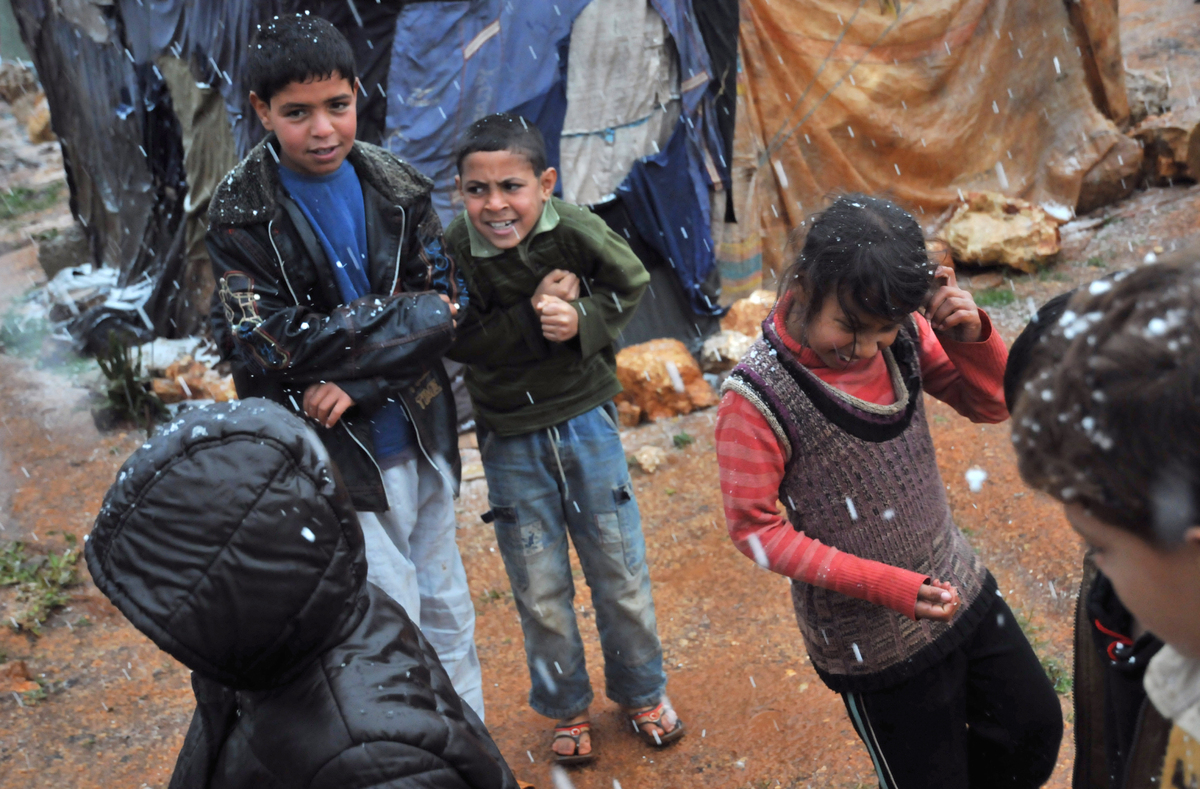While writing this piece, Margherita Moscardini learned that Abu Tamman died in the Za’atari Camp in July 2024. This text is dedicated to him and the great passion and love for his work, his family, and his home country.
Because it has been raining all night, Om Fidà has arranged a path of black stones, basalt, to reach the entrance of her house, to prevent anyone from getting stuck in the mud. She invites us to sit on the cushions she quickly transfers from the room next door to the central space, a covered courtyard for guests, to whom she can offer apricot juice.
That was in 2017 in the Mahallat al Ghouta, a street in Za'atari refugee camp in Jordan, where a large proportion of the Syrian population from Eastern Ghouta has resettled. As of January 2024, 78,000 Syrians reside in Za’atari. Eastern Ghouta is the region east of Damascus that the Syrian government has placed under siege since 2013, limiting water and electricity. Om Fidà, a former employee and mother of five children who’s previously worked with NGO in the camp, showed a video message she had received from her mother, still in Ghouta, forced to feed herself only with the vegetables she grows due to water shortages.
Water is precious in Za'atari. Although the camp was built in 2012 on an underground water vein capable of covering the needs of 80,000 people, Jordan ranks in the World Resources Institute’s “extremely high” category for water stress, with greater than 80% of the population requiring more water than is available to them. In 2017, each house in Za’atari was equipped with a water tank, which is filled periodically by tankers that drive through the narrow unpaved roads of the camp, forming a grid. Like many refugee camps, Za'atari is designed on the basis of the campus martius of ancient Rome. The grid is divided into districts and blocks where houses are numbered. Today, in addition to a water network that meets Jordanian national standards - with a centralized distribution and monitoring system that has reduced wheeled travel - the main roads have also been paved and more residents are using bicycles.
Water is precious in Za'atari. Although the camp was built in 2012 on an underground water vein capable of covering the needs of 80,000 people, Jordan ranks in the World Resources Institute’s “extremely high” category for water stress, with greater than 80% of the population requiring more water than is available to them.
By the time Za'atari camp was officially opened in July 2012, it was already considered Jordan's fourth largest city. Tents were quickly being replaced by caravans that many residents, on a private initiative, began to organize in empty spaces. In doing so, they somewhat reproduced the courtyard-house typology common in the Arab-Islamic world. Courtyards - traditionally understood as spaces in which guests are received - are covered in concrete to isolate the rooms from the ground. Concrete is also a good material to build the water fountains loved by the Syrian population in Za'atari, because "every worthy Syrian home has a nafoura." Using cement is still not allowed as it is on top of the list of materials which cannot enter the camp because they express an idea of “permanence”, so the walls of the caravans create a novel formation of the traditional courtyard. Nothing durable is accepted in the camp because its purpose is to be a temporary settlement, despite average camp residency lasting approximately 17 years. Initially, planting trees to produce some shadow wasn’t allowed because of water scarcity. Now gardening is a somewhat popular hobby in the camp, the plants simultaneously a symbol of hope as well as a sign of indefiniteness, signaling a prolonged intermediary stay.
By the time Za'atari camp was officially opened in July 2012, it was already considered Jordan's fourth largest city.
Restrictions have not prevented Za'atari residents from improving and embellishing their homes. Like many houses in the camp, Om Fidà's house has a small garden, as well as two caravans, only one of which is habitable. “Today” she wrote to me more than six years after we last met, “Za'atari houses are still made of sheet metal and prefabricated material that has deteriorated due to weather, sun, and rain. Even the concrete in the courtyard today is full of gaps.”
There was a time when the camp was growing rapidly as a town and was the center of attention, visited daily by actors, journalists, researchers, and ministers of countries who helped to fund services and infrastructures. This international attention gave hope for change, overturning the narrative of the refugee camp as an informal emergency settlement. In addition to schools, hospitals, clinics, soccer fields, and recreational centers, the largest solar panel system ever built in a refugee camp and an advanced wastewater treatment plant were constructed. The water purified from the plant was used to irrigate the fields of the surrounding farms where Syrian residents of Za’atari were employed as day-laborers. During this time a different aid distribution system was also experimented. Under the special protection program set up by the Jordanian Interior Ministry to manage the Syrian crisis, Syrian refugees receive a monthly subsidy that is credited to them on a card enabled for cash withdrawals. Cash circulation favored the opening of many businesses which are mainly gathered along the two souks. One of the souks is called Shams' Élysées, joking about the assonance between the famous Parisian boulevard and the Arabic denomination of the Syrian capital Damascus, Sham. In Shams’ Élysées there are more than 3000 stores and 300 restaurants have been operational for a while.
Along the Mahallat al-Ghouta Om Fidà’s family too had two shops, a candies shop and a vegetable and fruit store, where a hexagonal fountain, decorated in black and white tiles, was installed under the verandah. As they both were undergoing renovation, we saw the fountain in operation only two years later, in 2019, when Om Fidà sent us a video recording the store finally functioning and the fruits and vegetables being kept cool inside the fountain with the flowing water.
“That store has been closed for good, along with the falafel restaurant that started in the meantime” says Om Fidà on whatsapp, “because buying large quantities of vegetables has become too expensive. Instead of fighting off competition from larger stores, we preferred to open a canary store, a carpet laundry and a car and bicycle tire store.”
“One family in four different countries”
Every day Abu Tammam uses his own bike to take his wife to the school where she works as a teacher. They come from a village near Dara'a, the town in southern Syria where the peaceful protests that spread throughout Syria in 2011 began. In Syria, Abu Tammam studied mechanical engineering, but he used to work tending the family lands and cultivating his love for art. His wife taught Arabic in elementary school before being forced to move to Za'atari with her family. Despite being in her sixties, she still works as an Arabic teacher in the camp's schools. The school’s programs are the same as in Jordanian schools, and Syrian history and culture are integrated into the curriculum thanks to teachers like her who, working alongside their Jordanian colleagues, try to keep Syria's memory alive.
The school has been important for her youngest daughter who also developed a passion for the English language. She graduated with the highest score among students at Za'atari camp and she won an international scholarship to study translation at university. Here she met a Syrian fellow pharmacy student who became her husband, and now they live like her older sister in Saudi Arabia. Abu Tamman is the father of two sons also. The first one decided to remain in Syria; while the eldest, after a brief stint in Lebanon, reunited with his family in Jordan’s Za'atari. In the camp he met his wife who only recently, along with their two children, joined him in Germany, where he has been able to settle for about two years.
"Six members of one family in four different countries," Abu Tammam wrote to me in one of our messenger conversations we held in the past months. “Here” he says, “although services such as roads and water networks are good, people's quality of life suffers from the failures of donors who stopped honoring their commitments. In truth, between 2015 and 2020 there was a period of vitality and prosperity in the camp. So much aid was coming in, refugees had savings, and they had not yet completed the construction of their homes that aid started to decrease."
The situation worsened when the Coronavirus pandemic hit Za'atari like the rest of the world, first subjecting its residents to double confinement (quarantine and confinement in a camp), then forcing them to suffer the suspension of aid.
The situation worsened when the Coronavirus pandemic hit Za'atari like the rest of the world, first subjecting its residents to double confinement (quarantine and confinement in a camp), then forcing them to suffer the suspension of aid. The future of the camp mainly rests on the help by donors and, since they began to default on their commitments, job opportunities decreased and many businesses were forced to close. "The savings that the refugees had managed to set aside up to that point were used for priorities such as children, family..." continues Abu Tammam. "Five years ago, the camp administration expanded the drinking water and sewerage network, street lighting, asphalted the main roads and installed rainwater collection wells. But services such as hospitals and schools, for example, have not been implemented due to decreased funding. Since 2020, refugees able to work have been forced to work in the agricultural sector, and those who are allowed to work outside the camp actually do not have much work. Visits from United Nations officers and foreign guests have declined significantly over the past four years, as well as events that used to be frequent are now numbered."
Twelve years after its opening, Za'atari refugee camp remains a slum and the foundation of a city that needs renewed attention from governments, press, and the thousands of students who exercised their skills to imagine different ways of inhabiting, by taking Za’atari as a case study in their degree theses. Data from the United Nations High Commissioner for Refugees (UNHCR) reported that 4,060 Syrian refugees left Jordan during the first seven months of this year, marking an increase of 57% compared to the same period in 2023. Twelve years after its opening, Za'atari refugee camp needs renewed commitment from those who put a logo on a container or a blanket to engage with the future of a people. Either Za’atari becomes a city (whose inhabitants are free to live or leave) or it must remain in history as the last camp.
“You can mention my name now”
On the eve of the publication of this article, the regime of Bashar al-Assad falls at the hands of the opposition armed forces led by Hay’at Tahrir al Sham, forcing Assad and his family to flee to Russia.
Za’atari residents celebrate together like all Syrians around the world, although some caution is necessary to hold out hope that a transition to democracy is indeed Syria's near future.
Mohamad Khalf is among those whose home in Syria has been destroyed by the war. “There are families who want to return immediately because they have money and their homes are intact” he says. “There are families who want to wait because they don’t have money to renovate their homes. There are families who don’t want to return because they don’t have homes anymore in Syria. There are some families who say there is no security now.”
There are families who want to wait because they don’t have money to renovate their homes. There are families who don’t want to return because they don’t have homes anymore in Syria. There are some families who say there is no security now.
“We have to wait because there are families where people have died and they want revenge and we must not forget that there are many weapons among the people,” he continues. “If any simple disagreement occurs between the people, these weapons will appear. There are children carrying weapons in the streets and posing with them. There are families who bury weapons in the ground so as not to hand them over to the new state.”
He will have to wait longer before returning with the economic means to rebuild a home and a future for his family. On one thing, however, he does not hesitate: “You can mention my name, I think we have freedom of expression now.”


